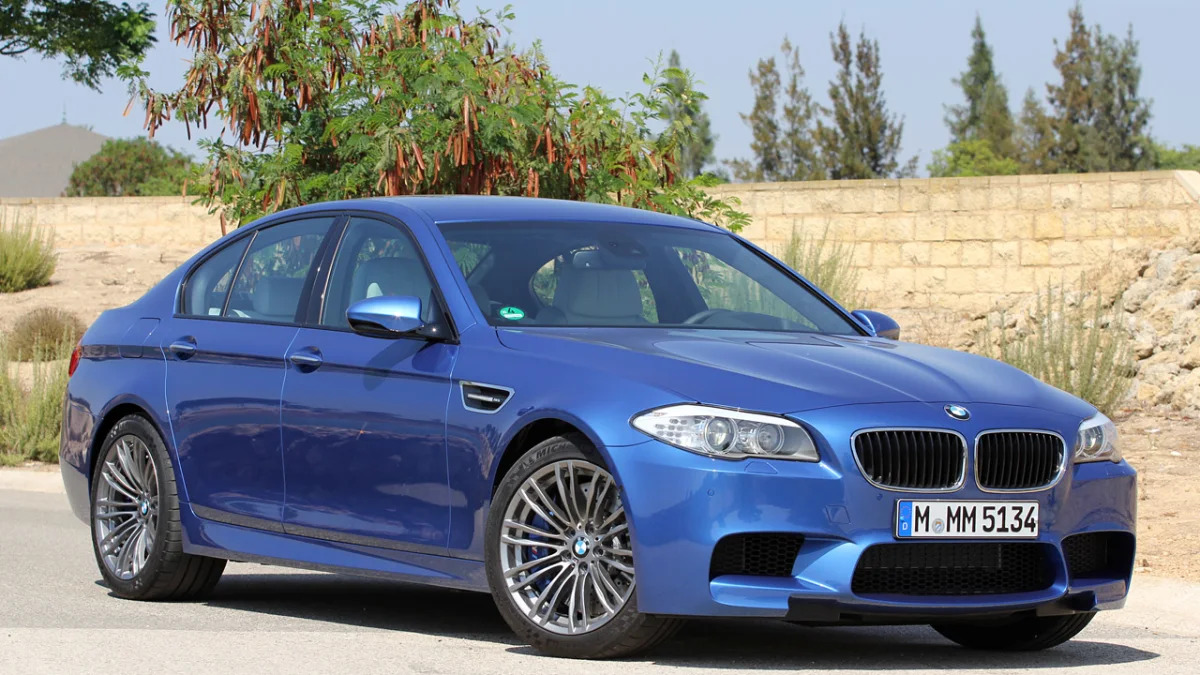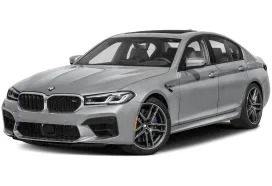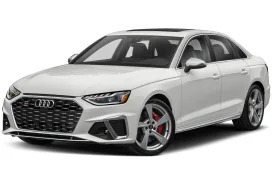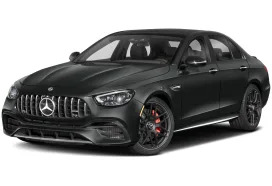-
EngineTT 4.4L V8
-
Power560 HP / 502 LB-FT
-
Transmission7-Speed DCT
-
0-60 Time4.2 Seconds
-
Top Speed155 MPH (limited)
-
DrivetrainRear-Wheel Drive
-
Curb Weight4,288 LBS
-
Seating2+3
-
Cargo18.4 CU-FT
-
MPG9.9 l/100km
Lose Two Cylinders, Gain Two Turbos, Take No Prisoners
The first BMW M5, the humble E28 of 1984, had little idea of the performance bloodline it would sire. Its equally humble sales figures proved it: just 2,241 were built. Previous to the 2004 arrival of the E60 M5, the '84 original and the much better-selling E34 that succeeded it in 1988 both carried excellent inline sixes that offered between 256 SAE horsepower in the first-generation's North American trim and 340 European DIN horses by the end of its run in 1995. Good for their time. The E39 M5, however, was the first model in the franchise that BMW really set loose, running an almost 5.0-liter V8 from 1998 until 2003 that offered up 400 hp in European trim. This generation did very well, finding its way into more than 20,000 driveways.
Beginning in July of 2004, BMW Motorsport went nuts, tying the entire M5 project to its famously costly Formula 1 involvement. Many racing fans would note that BMW's F1 program was not only costly, it achieved dismal results. At least their misadventure gifted us the E60 and its "holy crap!" all-aluminum 5.0-liter V10 engine. Compared to the three preceding M5s dressed in civilian clothing, the flared Chris Bangle-era M5 and its free-revving 500-horsepower S85 engine was a sequined Miss Universe contestant belting out power ballads. Again, over 20,000 were sold, almost all sedans, and, man, have we ever done a lot of impressively useless burn outs and hammering Launch Control starts ever since. By far, the United States has been the Number One market for E60s, with over 8,000 sold here before the building stopped in March of last year.
Then BMW left the F1 circus, F1 abandoned V10s, and Munich focused hard on a greener Efficient Dynamics gospel. The tear-jerking S85 was retired without fanfare.
['Scuse the long preamble, but with a new M5, it's crucial to remember from whence we've come.]



Today, we arrive at the "S63tü" 4.4-liter M Twin Power Turbo V8 chapter of the M5 oeuvre. Back at the launch of the E60 in 2004, BMW let us drive some good-but-not-great roads and then gave us Launch Control and slalom time at an old airfield in southern Germany. For this all-new F10 M5, they wisely got us on the first plane to southern Spain's beckoning mountain roads and onto the supreme Race Resort Ascari circuit. We thus learned much more this time about real world dynamics and exactly what it is the M5 is supposed to do for our little lives.
While the engine is technically taken from the X5/X6 M engine bay, its dual twin-scroll turbocharged unit has been significantly adapted for this application. There is now less boost from the Honeywell turbos (was: 14.5 PSI / is: 13.1 PSI) but the higher volume turbos work together with larger intercoolers to provide more and denser cool air more efficiently. This lowered boost allows a higher compression ratio of 10.0:1 versus 9.3:1 in BMW's overachieving crossovers, with the result being noticeably quicker responses in all drive modes. The redline with these two "no-lag" turbos is set at 7,200 rpm, a bit of a comedown from the last M5's 8,250 rpm banshee wail. BMW says the 2012 M5 is good for a 0 to 60 mph run in 4.3 seconds, but if we do not, at some point in the F10 M5's lifecycle, flirt with 4.0 seconds flat, then we will have failed you as automotive obsessionists; that's just how capable this S63tü feels.

Besides, with 553 hp between 6,000 and 7,000 rpm, power is up ten percent compared to last year's M5. Likewise, torque increases a whopping thirty percent to 502 lb-ft between 1,500 and 5,750 rpm, all while delivering 30 percent better fuel economy. The engine in the M5 uses a shallower oil pan and the S63tü is mounted one inch lower in the sedan's chassis versus how it sits in the X5 and X6 Ms. Up top, the cylinder heads are totally new and incorporate Valvetronic management of the valvetrain – a first among M vehicles. Pistons have been swapped out as well in order to achieve the 10:1 compression ratio. In case you were wondering, the "tü" incidentally stands for "technische überarbeitung", or technical revision.
Thanks to the M Dynamic Mode (essentially an M version of having the Dynamic Traction Control switched off), with rear axle Active M Differential frantically performing sophisticated feats of torque vectoring, this heavier 4,288-pound M5 comes off feeling no larger or heftier than the E60 M5. It feels decidedly more nimble, in fact.
Moving away from the punchy and sometimes complex SMG III single-clutch automated gearbox of its predecessor, the new M5 uses the M-DCT dual-clutch seven-speed (also from Getrag's vault), and it's generally smoother. In conventional Drive mode, the gearbox includes three M Drivelogic intensity levels, and there are also a trio of corresponding more aggressive manual S modes that'll have you grabbing the paddles. In S3, the quickest shifting mode, the new M5 has already ripped up the Nürburgring in 7:55, beating the company's fastest official lap with the outgoing car by about twenty seconds. It's a performance made possible by the new transmission combined with added oomph and the more versatile and quicker-thinking dynamics tech on board.
On both the long and empty hilly two-lanes around Seville and powering through lap after dreamy lap at Ascari, we work the M5's revs and its Boysen four-tip exhausts ad infinitum. The M Servotronic steering is only slightly aided by electronics, so mechanical joy remains through all those lefts and rights with their weight transfers. Do the twin turbos and lower redline take some of the sound and fury away? Yes, a little. But the new M5 is unfailingly faster, and its entry and exit characteristics in corners are simply beyond what was possible with the E60.


Looking down at the palm-sized M-DCT shift lever, we spy a horseshoe of analogue buttons for managing drive behavior. On the left, front to back, there are buttons for M Dynamic Mode/all traction aids off, throttle mapping, suspension feel via Electronic Damper Control, and M Servotronic steering weight. On the bridge to the right side of the horseshoe is the three-level Drivelogic button that calibrates the M-DCT dual-clutch transmission. On our testers, there were also buttons for the parking sensors warning system and the rearview camera in the iDrive display. We love that all of these bits have gone analogue and are not embedded in page after page of iDrive menus.
One button that should have definitely made it to this bank of controls is a P for parking. This is a frustrating unintuitive gap carried over from the E60. Put the tranny in neutral, engage the electronic parking brake and then press the Start/Stop Engine button to finish. What happens next is that the car starts beeping rhythmically, and at the bottom left of the dash, a text message warns that we have not put the gearbox in P for Park. But there is no P for Park to be seen anywhere, and you cannot magically get to Park via the M-DCT lever. The trick is to keep the doors closed and press the Start/Stop button a second time once the engine is off. Or you can just leave the car in-gear and running, poke the button and, for some reason, the system then defaults to P as the engine stops. Call us dopes, but this little headache makes no sense at all. If we owned an M5, we would get used to it, but why not just put a P button on the console or gearlever and make the world happy?




All the chassis and powertrain helpers get three settings: Comfort, Sport, and Sport Plus. The M Drivelogic gets three levels that still look like the cellular service bar display from the old SMG unit. The tamest setting for the throttle/engine map is called Efficient, but predictably, it's not much fun. We played around with all possible setting combinations during our rather sporting 200 miles on rural public roads, and the best overall setup for a sportier driver on public roads ended up being throttle/engine and suspension in Sport, steering in Sport (or sometimes Sport Plus), Drivelogic on the second or third bar, and stability nannies in MDM. We tried setting everything at their max levels of steroid use, and it was just unnecessary for over-the-road use.
At the track, we were almost all Sport Plus, yet we found that switching all stability tools off still felt like too much for this track, since Ascari's very tight layout was still daunting, particularly when trying to familiarize ourselves with the dynamics of a new car this large and powerful. Besides, MDM's thresholds are set plenty high, and our lap times were noticeably quicker when leaving it on. On a more long-legged circuit, though, we'd most likely go for it full-off. Ascari is best suited to an M3, M3 GTS, or 1 Series M Coupe.



We also took a shot at the M5's newer and more easily accessed Launch Control. Set the DSC to fully off, put the M-DCT in manual Sport mode with Drivelogic at level three, then, leaving your foot off brake pedal, hold the M-DCT lever forward until the dashboard indicates that Launch Control has been activated. Floor the gas pedal, hold your revs for a few seconds, and then release the M-DCT lever. It's pretty good stuff – quicker than the E60, and the shifts don't hit the back of your seat like a sledgehammer like the old single-clutch SMG III was fond of doing. Launch Control cannot be activated until the gearbox fluid is sufficiently warmed up, and the revs that you hold can be increased or decreased a bit by using the toggle lever between the two M Drive buttons on the steering wheel. Letting the hounds loose at 3,000 rpm felt best to us.
Side by side with the E60 M5, the F10 edition stretches 2.2 inches longer with 3.0 inches more wheelbase, spreads 1.8 inches wider (with a front track one inch wider than on the current civilian 5 Series and a rear track that's 1.8 inches narrower), but it stands 0.7 of an inch lower in height. The rear seats don't fold down, helping preserve rigidity, but trunk space is a very usefully configured 18.4 cubic feet. A clear BMW objective has been to create a sense of size and substance without actually making the car much larger. This new M5 looks, sounds and behaves less like a middle-ager's racing four-door (yet it succeeds in being a better racer its predecessor), and it feels more like a true senior executive stormer that can be used every single day. As BMW Group director of sales and marketing Ian Robertson puts it, "The new M5 is all about the right balance. It still favors its racing edge but can now be a very sophisticated executive car."




There are a few aspects that support Robertson's notion of balance. Not only did the E60 M5's V10 engine burn thirty percent more fuel over the same distance than the F10's bi-turbo V8, but its fuel tank contained 2.6 fewer gallons of go juice. So, the idea of making the new M5 a (more) practical long distance cruiser with the potential for 500 miles from a single 21.1 gallon tank rings true. The new M5 also has software enhancements that make life far more pleasant if and when you find yourself lodged in rush-hour traffic. Basically, the car is always less yippy, trying its hardest at all times to remain smooth. Among the many improvements in the cabin's driver interface and much clearer functionality, is the left spoke of the multi-function steering wheel, which now allows for two user-selectable M Drive total-car calibration setups. The intent is to allow quick access to one personalized setup for aggressive driving and another for cruising. The new M5's look is also less blatantly zoomy on the outside, hearkening back a bit to the subtlety of pre-E60 M5 generations.
The M5's 19-inch lightweight alloys get dressed with standard Michelin Pilot Super Sport tires – 265/40 ZR19 102Y front, 295/35 ZR19 104Y rear – and this rubber performed well all day long on both the region's demanding hot, sun-drenched roads and at the supremely dynamic 3.4-mile Ascari track with its 26 curves and exuberant elevation changes. Brake units are vented and drilled compound steel/aluminum discs with a six-piston fixed caliper in front and a single piston in back, measuring a big 15.75 inches in diameter front and 15.60 inches in the rear. A day full of hard usage didn't cause what we would call significant fading, though after a while, we did notice slightly softer pedal feel.

Speaking of which, the always vocal minority of frequent online opinionista that tries to tell us that the new 5 Series and M5 is either ugly or boring must be thinking out loud with their eyes shut. Think of those two words and this M5 ain't either. A Pontiac Aztek or Nissan Murano CrossCabriolet is ugly. A base four-cylinder Toyota Camry is boring. Settle your dander and dream of driving this car someday – it is a tremendously fine piece of work. BMW fully admits to having toned-down the M5's exterior in order to appeal to a broader cross section of buyers worldwide. It may not be as eye-catching anymore as the Jaguar XF/XFR or Cadillac CTS/CTS-V, but those two can only dream of selling in 5 Series/M5 quantities or of achieving its level of global notoriety and respect. The new interior is the best in this performance class bar-none. As to the performance itself, we cannot wait to get together an M5, Mercedes E63 with Performance Pack and a CTS-V sedan on our track of choice.
European customers start taking delivery of their M5s by December, while North American deliveries should begin as early as next July, with pricing starting right around $92,500.
At the end of our extended time with the F10 M5, all we lacked was that P button and perhaps a little more melodic roaring from the quad tailpipes. Simply put, the new M5 does for this more coddled segment what the Mercedes C63 AMG and M3 do for theirs: it sets the holy standard for mixing performance with luxury.













Sign in to post
Please sign in to leave a comment.
Continue